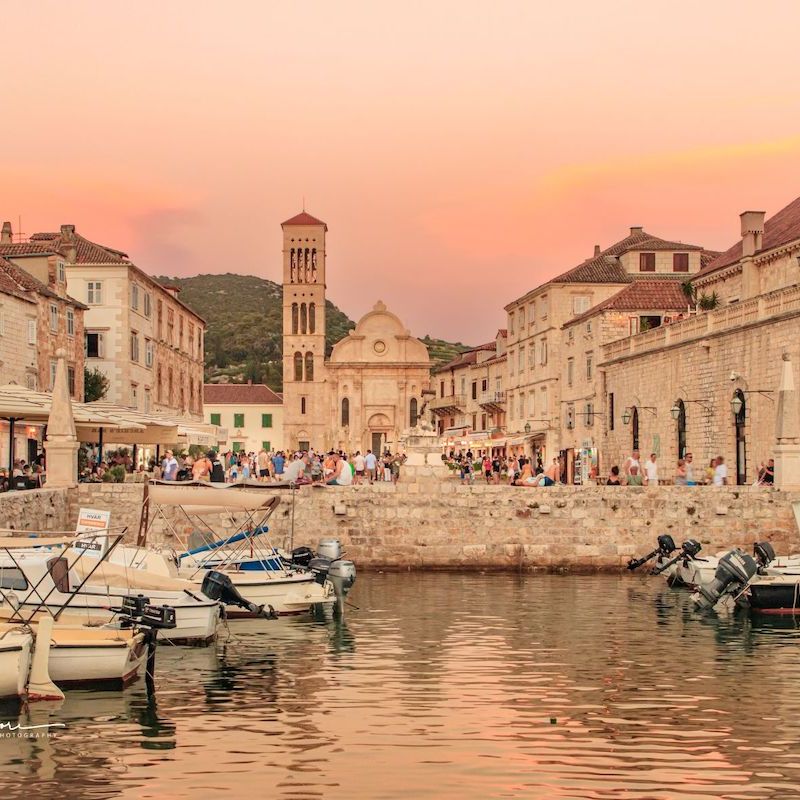
An overwhelming majority of TravelAwaits readers plan on going abroad this year, according to our recent State of Travel survey. Most of the international destinations on our readers’ 2023 itinerary are in Western Europe. Although just as beautiful and historic as their western counterparts, Eastern European vacation destinations are often overlooked.
Videos by TravelAwaits
Can’t-miss destinations like Prague and Budapest belong on your bucket list, but if you’re looking for something a little less touristy, you’ve come to the right place. Below, our expert travel writers share their favorite lesser-known locales in Eastern Europe and why they think you should visit them this year.

1. Berat, Albania
Dubbed “The City of a Thousand Windows,” Berat, Albania, is Teresa Otto’s recommendation. “Ottoman architecture makes the city a UNESCO World Heritage Site,” she tells us. Whitewashed stone homes with tile roofs cling to the hillsides of the Osum River that bisects the city. Yes, the houses seem to have more windows than walls.
Hike or take a taxi to Berat Castle to take in commanding views of the city below. Within the castle walls, Otto suggests visiting an iconography museum, admiring beautiful frescoes at the 13th-century Byzantine church, seeing remnants of an Ottoman-era Mosque, and buying handmade souvenirs from local craftswomen.
Outside of the sprawling 13th-century fortress, you can enjoy a tasting at one of Berat’s wineries or an alfresco meal with a view of hundreds of windows. Otto recommends visiting in May to experience Albania’s natural beauty at the Firefly Fest in the nearby village of Mbreshtan.

2. Hvar, Croatia
Sharing its name with the island upon which it is situated in the Adriatic, the port town of Hvar, Croatia, is a magnet for tourists in the summer months according to Chris Moore. “And for good reason,” he says, “Just an hour’s boat ride from Split, this ‘least small’ town on the island offers everything; from centuries of history (13th-century city walls and fortress) and fine dining (especially in the charming, water’s edge main square), to a splendid year-round climate and easy access to beautiful beaches.”
“Family restaurants spill out into already narrow alleyways and cobbled streets,” he describes, “with steps leading between ancient stone houses, the smell of home cooking permeating the air.”
Luxurious yachts are moored at the marina where rooftop restaurants offer the day’s catch as well as the best sunset views in town. It is a hub of activity as water taxis ferry visitors to many remote islands and beaches. “Check out St. Jerome,” suggests Moore, “Its beach is rocky, but sunbeds, umbrellas, and a beach bar as well as the warm, gin-clear water and nude-friendly beaches make this a popular visit.”

3. Pula, Croatia
“Like a finger dangling into the Adriatic, Pula is on the southern tip of Croatia’s Istrian peninsula,” Moore describes. Having been occupied by Romans, Venetians, and Austrians, to name a few, the seafront city oozes history. Pula is famed for its outstanding Roman amphitheater, which is one of the largest surviving in the world. Rich history in a beautiful environment? Sign us up!
“With summer temperatures in the mid-80s, combining exploration of splendidly preserved architecture in the morning and swimming in the clear turquoise Adriatic from a nearby beach in the afternoon makes for a perfect vacation day,” according to Moore.
He suggests catching a spectacular sunset while enjoying freshly caught fish at one of many local restaurants.
Just offshore, the 14 Brijuni Islands make up a national park where you can explore ancient architecture, glorious landscapes, and wonderful beaches. The national park also boasts around 200 dinosaur footprints!

4. Karlovy Vary, Czech Republic
Located in the Czech Republic’s west Bohemia region, Karlovy Vary is an easy 90-minute drive from Prague. Best known for its thermal springs, riverside stroll, and the Grandhotel Pupp, this spa town is Gail Clifford’s pick for Eastern European town our readers should visit this year. Made famous in movies like Casino Royale and Last Holiday, Karlovy Vary hosts its International Film Festival the first week of July.
Clifford recommends spending the day hiking in the hills and taking in the views from observation towers above the town and along the river. Then head back to relax in the healing waters of the thermal baths before treating yourself to some apple strudel at the Grandhotel Pupp.
“Want to participate in the Becher Drinking Cure?” asks Clifford, “Have your list of the town’s 13 mineral springs ready and drink from each to receive the full effects of the ‘cure’ from medicinal properties found in the unique mineral composition from each spring.”

5. Litomyšl, Czech Republic
Although it is not a major tourist destination, Litomyšl is one of Karen Warren’s suggestions for where to visit in Eastern Europe this year. Located in East Bohemia, 100 miles from Prague, Litomyšl is known for its spectacular Renaissance castle and for its charming town center.
Litomyšl Castle is a UNESCO World Heritage Site. “This is because of its Italian-influenced design, including a large central arcaded courtyard, and its lavish Baroque ornamentation,” explains Warren. Visitors can take a tour of the castle and enjoy a stroll through its gardens.
“Litomyšl itself is a timeless Bohemian town,” describes Warren, “At the center is Smetana Square, surrounded by arcades, churches, and public buildings. There are lots of places where you can enjoy typical Czech food and the local beer!”
Warren says the best time to visit Litomyšl is between May and September when you will enjoy the warmest weather. The annual Smetanova Litomyšl music festival (named after the classical composer Smetana who was born in Litomyšl) takes place in June and July.

6. Riga, Latvia
Although Riga is the capital of Latvia, you still may not have heard of it. Samantha Priestley tells us that the old medieval town is beautiful to wander around. “I love the original wooden buildings,” she says, “If you go in the winter, it’s even prettier in the snow — it feels like a real old-world Christmas town.”
In summer, the squares come alive with locals eating out and socializing into the small hours of the night. Priestley suggests strolling the sunny lanes and admiring the architecture. According to Priestley, “The market is really good, especially the food market, and the town square is stunning. It feels old, but I found a karaoke bar that was at odds with the old town’s appearance, and a lot of fun.”
Authentic Baltic cuisine is not cheap but Priestly says that it feels worth it because it is so good. Riga is becoming more popular, so Priestly recommends visiting this year before it gets too busy.

7. Tarnów, Poland
Full of classic Renaissance and Gothic buildings and brimming with history, Tarnów is like a smaller version of Kraków in some ways according to Warren. However, she assures us that this Polish town, which lies 50 miles east of Kraków, is much lesser known and less visited by tourists.
“Start at the Main Square and the Town Hall Museum, then spend some time just wandering around the quaint medieval streets,” recommends Warren, “Don’t miss the former Jewish Quarter and ruined synagogue where information boards tell the story of the town’s Jewish community. Then there is St. Mary’s Church, a 15th-century wooden church that is typical of the region.”
Warren says that the best time to visit is between April and October as the winter months can be incredibly cold and wet. In June 2023, Tarnów will be one of the venues for this year’s European Games. There is also a full program of music and cultural events throughout the year.

8. Brasov, Romania
In the shadow of the peaks of the Southern Carpathians, Brasov is home to gorgeous medieval architecture. It was also home to Emese Fromm as a teen and she contends that the Transylvanian town is one of the most beautiful destinations in Eastern Europe. Fromm plays tour guide when she visits the Brasov with her family.
“We like to start our city tour with its most distinctive feature, the country’s largest Gothic building, the Black Church. With its outer walls still blackened from the fire of 1689, the church is home to one of the largest organs in Eastern Europe. From here, we walk over to the Old Town Hall Square surrounded by colorful medieval buildings. For a history lesson of the city, I take my kids to Catherine’s Gate, the Bastions, and walk through the Schei gate, all built in and around the 16th century,” says Fromm.
“But our favorite activities in Brasov are just outside of the city, in the surrounding mountains. We hike up Mount Tâmpa — though you can take the cable car if you’d rather not hike uphill — and enjoy the views of the city below,” she tells us, “You’ll find even better views though from the road up to Poiana Brasov, the resort above the city, our favorite spot to spend time in around the city.”

9. Sighisoara, Romania
Less than a couple of hours from Brasov, Sighișoara is known as one of the few medieval citadels in the world that is still inhabited. Fromm, who grew up nearby, says Sighisoara is her husband’s favorite town in Romania and calls it a can’t-miss when visiting the country.
“We like to spend most of our time in the historic city center, a UNESCO Heritage Site,” Fromm tells us. She suggests visiting the clock tower to learn about history, see a unique tower clock from the inside, and walk out onto the tower’s balcony to enjoy the views of the city in every direction.
Located in the historic Mureș County region of Transylvania, Sighisoara transports visitors to the Middle Ages. “Strolling through the streets of the historic center and visiting the bastions once used to defend the city, you’ll have a sense of being in a fairytale,” Fromm describes, “The city center truly turns into a medieval history book in July when it hosts the oldest medieval festival in Romania.”

10. Piran, Slovenia
A charming coastal city on the Adriatic Sea, Piran makes some of the finest sea salt in the world. Traveling south of the Slovenian capital of Ljubljana is less popular than heading north towards Lake Bled, according to Carol Colborn, although the southern route features stops such as Postojna Cave and Predjama Castle.
Colborn recommends treating yourself to a sumptuous seafood lunch, then heading up the hill from the festive Tartini Square to the Church of St. George, which offers some of the “best views of the spit and the town’s red rooftops cascading into the sea, very much like in Croatia,” describes Colborn.
Winding alleys take you to the Monastery of St. Francis of Assisi, which dates back to the 14th century. “Descending into the spit’s tip, I found the most beautiful Christmas tree I have ever seen,” Colborn recalls, “To the left, I could see Croatia’s coast (accessible in three hours by car) and to the right is Venice (three hours by ferry).”

11. Zemun, Serbia
Once a famous border town between the Ottoman and Austrian Empires, Zemun now serves as a suburb of Belgrade, the Serbian capital. Filled with small, colorful houses, crooked, cobbled lanes, and plenty of restaurants lining the shore of the wide, slow-flowing Danube, this little town is Ulrike Lemmin-Woolfrey’s proposed Eastern European destination for 2023.
She suggests climbing up to the tower on Gardos Hill for spanning views across the countryside all the way to Belgrade, and visiting the cemetery on the hill. “This cemetery is quite unique in that it is the resting place for the mix of religions found here, from Orthodox and Catholic Christians to Jews and Muslims,” she says, “There is also a pretty church and historic synagogue.”
“Walk along the Danube back to Belgrade,” recommends Lemmin-Woolfrey, “stopping along the way for some of Serbia’s best seafood — or simply a drink or snack — on one of the many houseboats moored along the shore.”
Related Reading:
